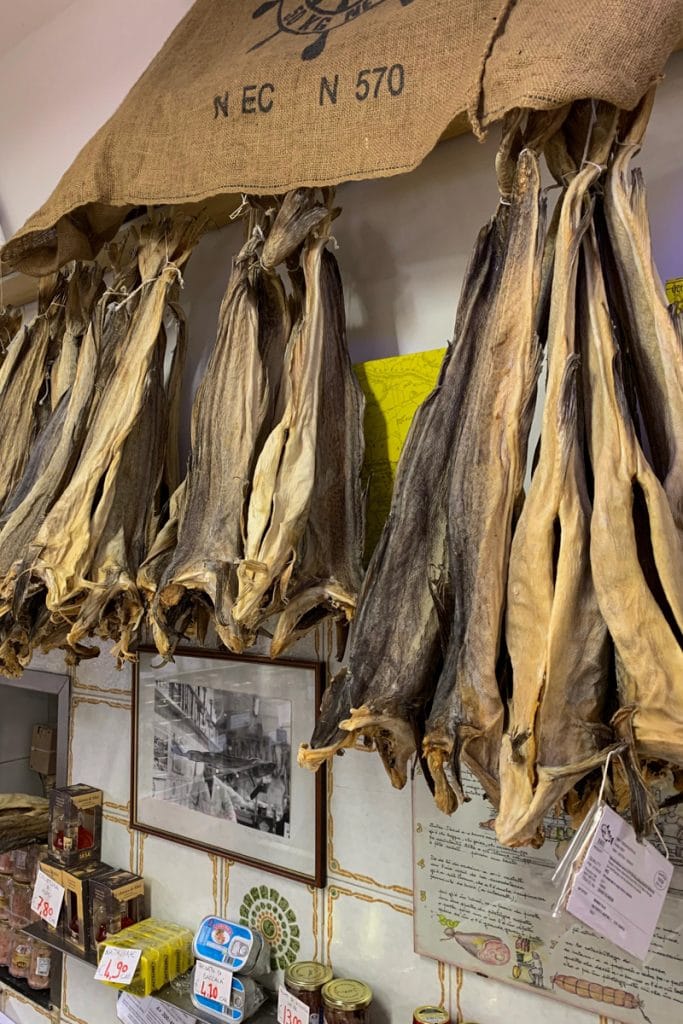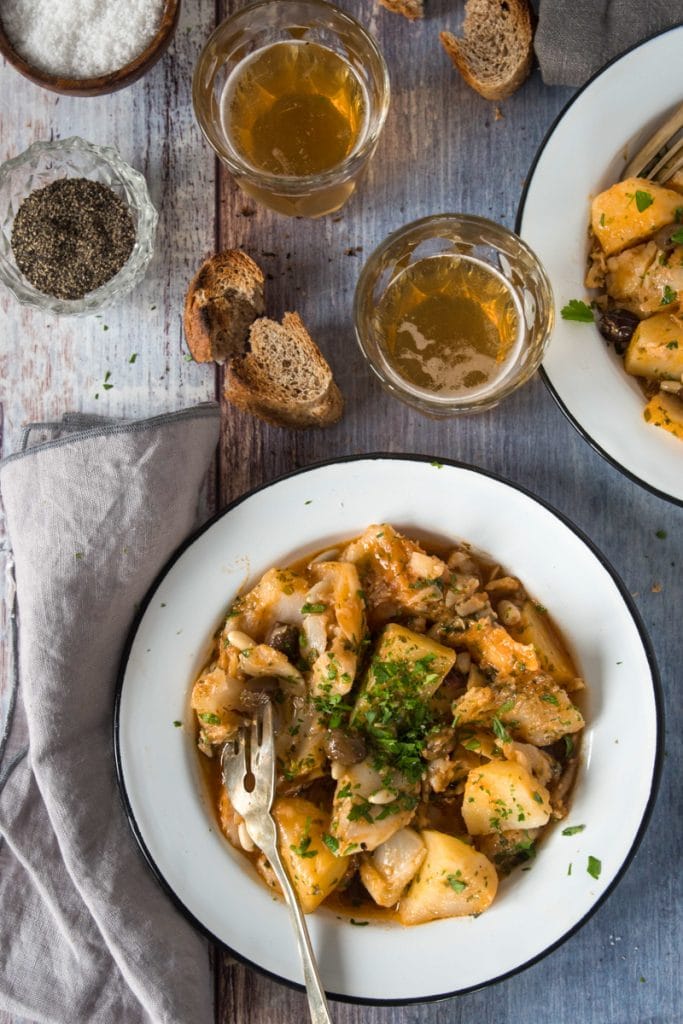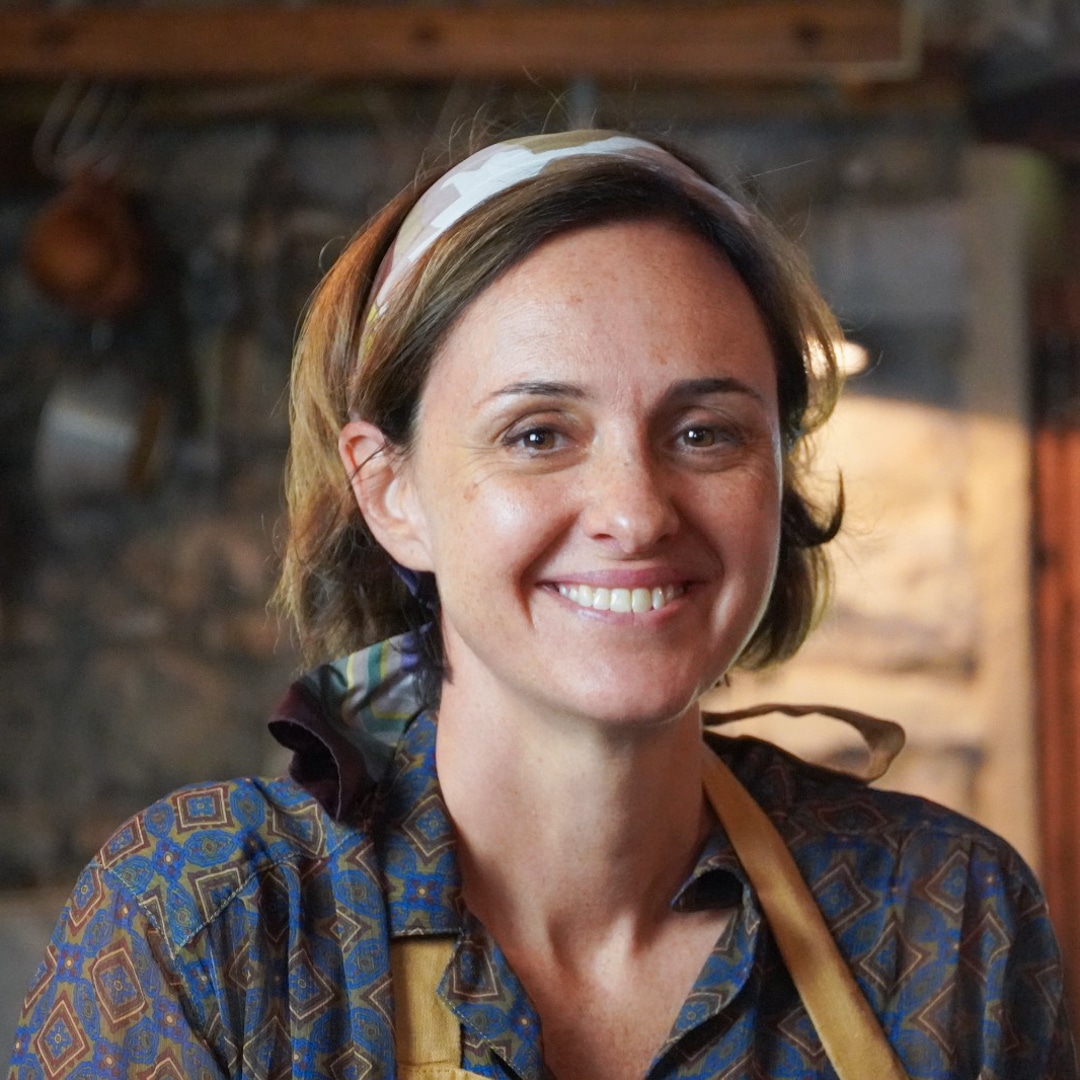The recipe for Ligurian stockfish stew “stoccafisso accomodato” has been in my pen for some time and was just waiting for a good opportunity to get out.

This came with Peter and Concetta, a happy retired Australian couple who attended one of my last cooking classes. She, originally from Caserta (close to Naples), emigrated to Australia when she was 12 years old. There she met Peter with whom today, after many years together, she shares 14 grandchildren. During the cooking class she spoke tirelessly, sometimes in English with a strong southern Italy accent, others in Italian with a strong Australian accent. Peter on the contrary most of the time was silent and concentrated to cook following my directions.


Cooking classes are now a constant commitment, to the detriment of my little blog which is updated more and more occasionally, but they are a wonderful opportunity to meet extraordinary people from all over the world and to cook traditional dishes.
Indeed, at home with the kids I seldom have time to pour all my heart and soul in cooking traditional dishes taking care of the smallest details. On the contrary, during cooking classes, I do, because cooking is the heart of the experience and I‘m all in it. From the choice of the raw material, to the careful preparation of the dish, to the history of the origins of the recipe.
Often I vary my class menu to include the traditional dishes I love most. So doing I must develop the recipe in writing, to translate it into English for my guests (to whom I always give a booklet with the recipes we have prepared together) and to deepen the history of those dishes. One of the fundamental ingredients of my classes, indeed, are the stories and traditions that each dish brings with it.
So, a couple of weeks ago, during the cooking class with Concetta and Peter I decided to cook as a main course the Ligurian stoccafisso accomodato, literally stockfish stew. The recipe didn’t need testing, it’s the one I’ve always prepared at home. I just had to write it down and translate it into English. While on the history of stockfish I had fun doing some research. So today’s post got together: history and recipe of stewed stockfish.
Brief history of stockfish in Ligurian cuisine.

Stockfish is nothing but dried cod fish. The name could derive from the Norwegian stokkfisk or from the ancient Dutch stocvisch, that is “stick fish”. In italian it is stoccafisso.
Norway produces it since ancient times. The best is the one from the Lofoten islands. Here the cod is captured, beheaded, opened along the backbone, leaving the halves joined by the tail and left to dry in the open air on wooden racks, from February to May. The climate of the area, dry and cold, just above zero and without rain, allows perfect drying. After months outdoors, the stockfish matures for another 2-3 months indoors. At the end of the process the fish will have lost about 70% of its original water while maintaining all its nutrients. Soaked for at least three days in running water to soften it, it is then pounded and cleaned, so it can be prepared in many ways.

Be careful not to confuse stockfish with baccalà, or baccalao, which is always cod but salted. Using salt is another very ancient way of preserving fish. Also in this case the fish need to be soaked in running water for two days for letting salt go.
In Italy the stockfish seems to have arrived around 1450 through the Venetians (by accident shipwrecked in the Lofoten and saved there by the local populations). In Liguria, however, it spread around 1600 thanks to trade with the Portuguese.
Its great diffusion in our cuisine is due to a series of different contributing factors. First, stockfish is a product that can be kept for a long time, which made it suitable for being stowed on board ships, on the one hand to feed sailors during long journeys in the open sea and on the other hand to be marketed in the Mediterranean (let’s not forget that the Genoese were skilled merchants).Furthermore, according to the Catholic Church faith had to observe dozens of “sacrifice days” during the year (consumption of animal products is prohibited, except for fish). This observance therefore led to the development of a fish-based cuisine and cod, for its low cost and ease of conservation, became very popular among the less wealthy Catholic families


Thanks to its popularity Liguria included stockfish in the list of its traditional agri-food products.
Among the best-known dishes there are “stoccafisso alla badalucchese”, from the municipality of Badalucco, located in the Argentina Valley, in the Ligurian hinterland, which is a stew made of stockfish, dried mushrooms, nuts and olives.
Then we have brandacujun, a typical dish of the West Riviera based on potatoes, stockfish and a lot of extra virgin olive oil.
While in Genoa two are the most traditional recipes. One is “stocche e bacilli”: a stew of stockfish and dried fava beans (of Tunisian origin) typical of the day of the dead.
The other is “stoccafisso accomodato”, my recipe of this post, a stockfish stew with potatoes that brings all the flavor of our region: pine nuts, olives and tomatoes.


Ingredients
- 700 gr of stockfish
- 5 potatoes
- 1 small white onion
- 1 clove of garlic
- 1 small bunch of parsley
- 4 salted anchovies, cleaned
- 5 ripe plum tomatoes
- 2 tablespoons of pine nuts
- 1 tablespoon of tomato paste
- 1 tablespoon of salted capers, abundantly rinsed (optional).
- 2 tablespoons of olives (Taggiasca olives possibly)
Instructions
- Put the stockfish in boiling water for a few minutes, then drain and remove skin and bones.
- Peel the potatoes, cut them into large pieces and leave them to soak in water and salt.
- Dice the tomatoes.
- Prepare a chopped mixture with half a bunch of parsley, garlic and onion.
- In a high-sided saucepan, sauté the chopped vegetables in 4 tablespoons of extra virgin olive oil together with the salted anchovies (which will melt in the oil during cooking).
- Add the stockfish in pieces, the pine nuts and, at your discretion, some capers. Let it brown over high heat for a couple of minutes.
- Add the tomatoes, the olives and a tablespoon of tomato paste dissolved in a ladle of warm water.
- Cook over low heat for 20 minutes, making sure that the stockfish does not dry out. If necessary, add a little hot water.
- Finally add the potatoes and cook, with the lid, over a moderate heat for 15 minutes or until the potatoes are tender. Taste and adjust with salt and pepper.
- Before serving you can sprinkle with extra chopped fresh parsley.

To close, I would like to mention a beautiful book (in Italian and English) photographed by my friend Francesco Zoppi : “The Codfish Tale”. Inside, the in-depth history of stockfish and the link between Genoa and the Lofoten islands combined with a selection of recipes prepared by top-level Chefs, all tied together by Francesco’s breathtaking photographs. Like the one of the stockfish fields under the northern lights that you have seen above and with which in 2019 he arrived in the final at the “Pink Lady Food Photographer of the year” photo competition. For more information, you can contact the author directly here: info@francescozoppi.com






